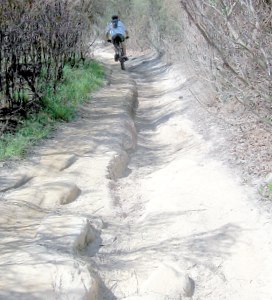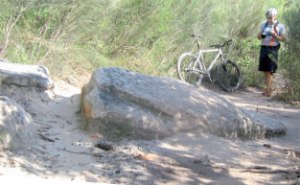Pauli's Rant
As mountain bikers we like to consider ourselves as a ‘respectable bunch’— unfortunately this isn’t always the case. Paul Lidgard looks at what we can do to clean up our act.
*Paul Lidgard is the vice president of Terracare and the Trails Liaison for Manly Warringah MTB Club. He has been involved with trail access issues in his local area for 8 years. He is also a devoted single speeder and believes that you only ever require one gear! I have been involved in trail advocacy for many years now and over that time there has been some great things come out of the trail advocacy movement. Especially some of the relationships made between land managers/landowners and the trail liaisons that volunteer their time, these relationships have made trail access available for all of us to ride.

So I am extremely disappointed when I see people riding in the rain on trails that are signposted as ‘closed due to the wet conditions’. Like most people, I get withdrawal symptoms from not riding but boredom is no justification for wrecking the trails. I was told by one daft soul, “I am going to ride anyway as I have not ridden for a week and driven an hour to get here.” He told me this after I had described the damage he would do to the trail and after I had informed him of the substantial volunteer hours that had been put into the area. I won’t go into what my finishing message was… After thinking/brooding over this incident, I thought of a few things we can all do on an individual basis to maintain our trails and keep other trail users and land managers on side.
Don’t ride in the wet or even a couple of days after heavy rain.
The erosion damage caused by mountain bikes in the wet is extraordinary. During a two week rainy period, the erosion caused by a low traffic volume on a section of clay based singletrack is equivalent to two or three years of high traffic use in the dry.
The trench digging and wheel ruts will be deeper from two weeks of wet weather riding. In saying this there are trails out there that cope well with wet conditions, however they are far and few between. The best thing to do is grab some slicks and get out and do some road riding.
Maintain control of your steed.
Ride your bike at a speed that you can control, keep smooth and keep skidding to minimum. There is always a chance of walkers, animals, new obstacles and other riders out on the trail so always ride within your ability to prevent accidents.
Don’t ride permanently closed trails.
Nothing frustrates land managers more than a blatant disregard of park rules,
as this in turn makes the trail liaisons job that much harder,
when it comes to gaining greater trail access.
Don’t modify trails.
In my area there are a few technical sections, unfortunately some people have decided to make new lines or widen the track so they can ride or short cut that section. Please don’t do this! Firstly, it causes erosion by allowing water to flow through these new areas and secondly, it detracts from the nice tight nature of a singletrack trail—something that we all love. If you have trouble riding some sections, keep practicing or go do a mountain bike skills day, none of us are too old to learn!
 Noise at the trailhead.
Noise at the trailhead.
Keep noise to minimum at the trailhead— especially in the early morning and the evenings when you are outside resident’s homes or riding past houses. People who don’t ride don’t appreciate you talking loudly outside their house at 7am on a Sunday morning! You may not think you are that loud but if your mate can hear you on the opposite side of the street, then you are talking in a ‘low yell’ and destroying the morning peace. By keeping noise to a minimum we keep the local residents on our side. They are a large lobby group so fewer complaints means that the land manager have fewer headaches to deal with.
Take your rubbish with you.
In this day and age there is no excuse for littering.
Don’t leave tubes or gel packaging out on the trail.
As the old saying goes; if you carried it in, carry it out.
Take ownership of your local trails.
See if there are trail work days and attend two days a year. Find out through your local mountain bike club, the land manager, Terracare or MTBA. Join in and have a say on how your local trails are maintained or get involved with the management and growth of your local trails. Some land managers and mountain bike clubs have websites that inform you if the trails are open. You may be able to join an email list that provides updates on trail conditions when needed. This helps you to plan your rides based on the trails that are open.
At the end of the day, we as individuals all need to do our bit towards trail care. If we can show care and responsibility as a community group we will gain greater respect from land managers. This in turn will increase our riding opportunities and cement continued access to our favourite riding areas

 Noise at the trailhead.
Noise at the trailhead.



